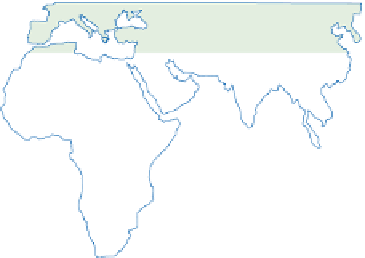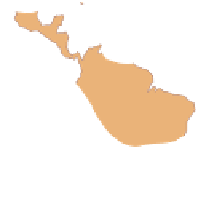Geoscience Reference
In-Depth Information
LONGITUDE
150
120
90
60
30
0
30
60
90
120
150
180
40
40
20
20
0
0
20
20
+XPLGWURSLFV
7UDGHZLQGDUHDV
40
40
150
120
90
60
30
0
30
60
90
120
150
180
Figure 27.1
The humid tropics in relation to the main trade-wind zones. Areas toward the boundary of the region are humid for
part of the year only.
zone there is a drier period when rain days are fewer.
It is at this time of year that burning of the forest takes
place. This somewhat drier season is experienced in most
of the equatorial trough zone, though its intensity and
duration vary. Only a few areas have no drier season. For
example, Padang in Sumatra (Indonesia) receives an
average rainfall of 4,427 mm and only one month has less
than 250 mm. The driest season occurs when the trough
moves farthest polewards in response to continental
heating in the summer hemisphere. As one moves
farther away from the equatorial trough zone so the dry
season lengthens and we reach the monsoon areas.
Ironically annual rainfall totals in monsoon areas can be
even greater than in the humid tropics, where factors
favour rainfall, though there is always a strong seasonal
pattern. At Cherrapunji, in Assam, the Khasi hills provide
orographic uplift of moist monsoonal air from the Bay
of Bengal to give a mean annual total of 11,074 mm
but virtually no rain falls between November and March
(see
Chapter 5).
The humid tropics cover a wide range of climatic types
and hence show considerable environmental diversity.
Temperatures are fairly stable throughout the tropical
world, tending to be somewhat higher during any dry
season and cooler and with a smaller diurnal cycle during
the wet season. The main variable is the quantity of rain
and its seasonal distribution. In this section on climate,
for completeness, we have included some areas which
have a relatively short dry season because the origins of
their climate are similar to more humid areas. For the rest
of the chapter we will concentrate on the more humid
areas where the dry season is shorter than the wet season
and there is a annual surplus of moisture.
variety - the Doldrums, the intertropical front, the
intertropical convergence zone, intertropical trough,
equatorial trough or intertropical confluence zone. For
simplicity we shall refer to it as the equatorial trough,
although it does extend towards the subtropics, and is
quite variable in character.
The equatorial trough has many different forms. It
represents the area of low pressure somewhere near the
equator towards which the trade winds blow. The precise
form it takes will depend upon the stability of the trades,
their moisture content and the degree of convergence and
uplift. Much of the trough is over the oceans and it is only
recently that satellite photographs have shown us more
of its movements (
Figure 27.2
).
The structure of the trough is variable, with an element
of a hierarchy of cloud. Larger elements called cloud
clusters, perhaps 100 km to 1,000 km in length, may be
found. Within the cluster there are convective cells, and
embedded in the cells are individual convective elements
which can give the heavy rain characteristic of the
equatorial trough. Over the continents the convective area
expands considerably, as seen over central Africa in
What is the climate of the equatorial trough like?
Figure
27.3
gives an example of mean monthly temperature and
rainfall for Manaus in Brazilian Amazonia. The mean
monthly maximum temperature varies by 2·8
C over the
year and the mean monthly minimum by only 0·6
C.
Extremes are rare and insignificant by temperate-latitude
standards. The diurnal variation of temperature is more
noticeable than the annual variation. At Manaus mean
annual rainfall is high, with 1,811 mm, though even in this



































































































































































